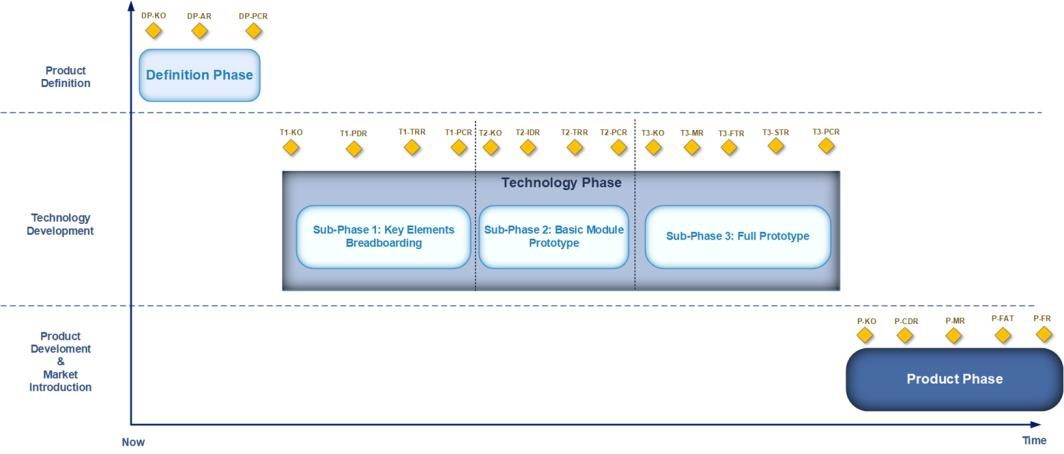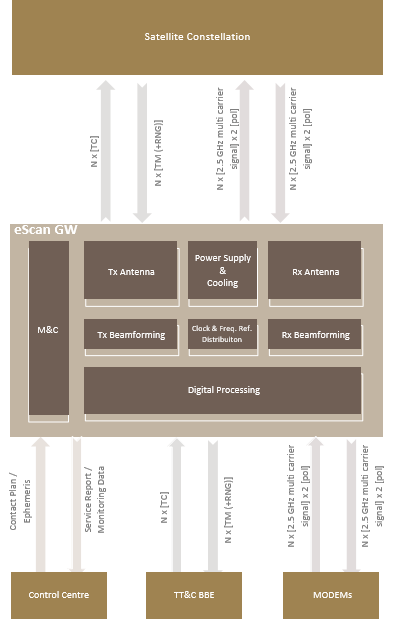
-
StatusOngoing
-
Status date2019-01-17
-
Activity Code6B.052
The project objectives are focused in developing a novel ground station concept combining gateway and TT&C services based on an advanced electronic scanning multibeam antenna product (eScan) able to track simultaneously several Ka-Band satellites of LEO and MEO satellite megaconstellations.
The product solves and incoming satellite mega-constellations system inefficiency/problem- the need for a large number of different motorised- based reflectors farm to track many non-GEO satellites from a certain teleport site- in a very innovative way.

The main challenges of the project are technical and arise from the combination of the high demanding requirements in terms of:
- High Bandwidth
- Large Scanning range
- High Gain
- Large number of beams
They impose several design decisions in order to maintain the product complexity at a manageable level while providing high performances based on the state of the art of several key technologies.
The eScan antenna represents a new paradigm for the Satellite Ground Stations, and evolves completely the way they are designed, produced, implemented, tested and operated, with many benefits of all types associated:
- Economic benefits; savings both in OPEX and CAPEX associated to ground infrastructure, operations and maintenance.
- Installation simplification; instead of a large network of ground stations, just a eScan on the top of the control room dome.
- Maintenance; lack of mechanical motion eliminates the possibility of mechanical breakdown guiding to less repairing works, failure events, …
- For the environment. The substitution of extended farms of many motorised reflectors by a single electronic antenna without moving parts implies less installation surface, less noise, less power consumption, and is ecologically wise.
The main features of eScan are:
- Modular system: Reliability and Graceful degradation.
- Flexibility for antenna upgrades.
- Multifunctional antenna able to support multiple functions and services.
- Electronic beam and beam agility.
- Multibeam: single antenna coping with several satellites
- Lighter systems and Less power consumption compared to mechanical antenna-based systems.
- No moving parts: Lower long-term maintenance cost than its mechanical counterpart.
- Easy maintenance and coordination with operations
The architecture of the product is based on the following building blocks:
- Tx and Rx Active Array Antennas; separate antennas for TX and RX are envisaged, because the 20/30 GHz bands are too distant to allow a single antenna.
- Clock and ref. signals distribution
- Digital Processing
- M&C subsystem, and the auxiliary subsystems; electrical, structural, etc.·
And the following external interfaces:
- Space to ground interface in what concern to Ka-band gateway and TTC.
- TTC and user segment MODEMs interface
- Control Centre interface which for contact plan reception and health and service monitoring information reporting
The overall development logic of the project considers the following phases:
- Definition Phase. The required trade-offs and analysis are performed in order to define the preliminary product concept, technical solutions and product requirements.
- Key Elements Breadboading devoted to the eScan antenna full prototype design and critical technologies breadboarding
- Basic Module Prototype, basic building block for the construction of the antenna based on its repetition.
- Large Scale Prototype Integration and Validation. It is a representative model of the product with the relevant functionalities able to be validated in a relevant environment.
- Product Phase. During this phase, the final industrial version of the product is developed.

Project is at the beginning of the Definition Phase. On-going activities include the initial analysis and trade-offs to be reviewed in the Mid Term Analysis Review (DP-AR) milestone.
Initial efforts have been put on:
- Identification of ways to reduce the antenna complexity while maintaining a high level of performance,
- Basic structures to be used as antenna building blocks.
- Identification of technology partners.




